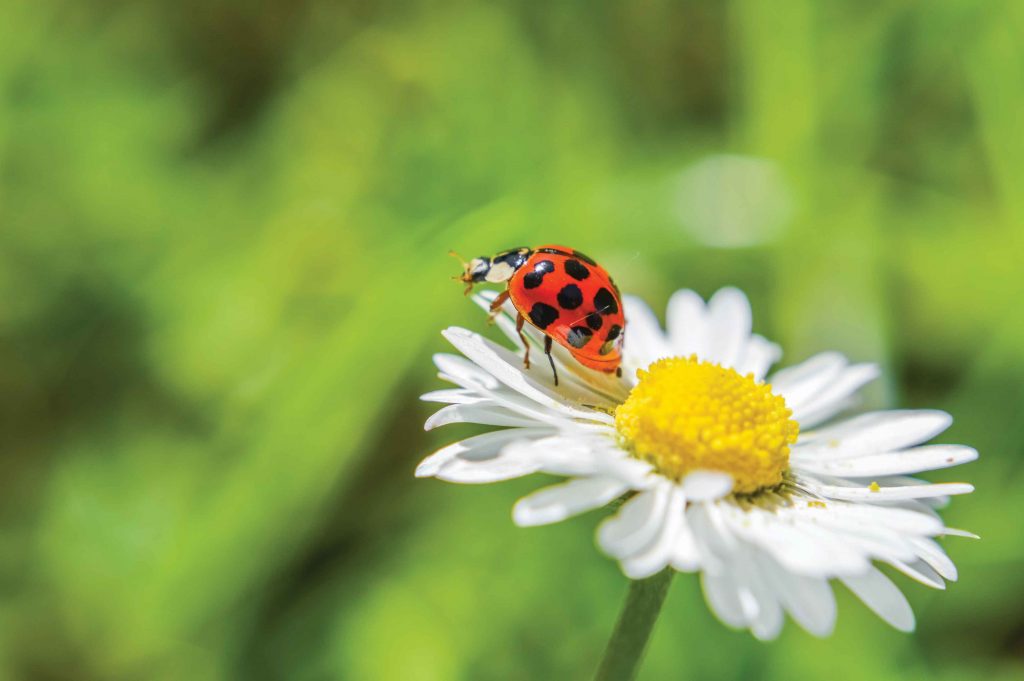By Gary Jones | Special to the NB Indy

— Photo courtesy Armstrong Garden ©
“Good” bugs can be a homeowner’s best friend, while “bad” bugs can wipe out weeks of gardening in just a few days.
By definition, it is easy to know the difference. The notorious bad bug gang of four – aphids, whitefly, scale and mealy-bugs – feed on plants and can cause severe damage.
The good bug club includes ladybugs, praying mantises, green lacewings, hoverflies and parasitic wasps. They have a different food preference and feed on bad bugs. Good bugs end a delicious meal of bad bugs with the nectar of flowering plants for dessert.
Ladybugs are beloved and well-known beneficial insects, and praying mantises will eat aphids, whitefly and others.
Fragile-looking green lacewings feed on aphids, mites and other small insects and insect eggs. Hoverflies look like little bees, hovering and darting in the garden. They feed on aphids, mealybugs and others. Tiny mini-wasps that don’t sting, parasitic wasps, lay eggs in the bodies of insect pests. After hatching, they feed on the host pest.
This dream team will also allow you to garden as safely as possible. There is no need to worry about harming pets or children with chemical sprays. You are also encouraging biodiversity in your garden by gardening organically.
Ladybugs harvested from colonies in California’s foothills can be purchased spring through summer at most garden centers. They will stay in your garden as long as there is something to eat. If they leave, that is OK. It means your garden is clean and they have probably moved on to your neighbor’s yard.
Praying mantis egg cases can also be purchased, but only during spring. They will hatch by summertime. Each egg case is placed in your garden where the mantises will hatch and meander through your garden. It is always a bit startling to meet up with a full-grown mantis later in the summer. Although they are forlorn and harmless, it is clear they have eaten more than a few bad bugs once full-grown.
Green lacewings must be special-ordered at your neighborhood nursery but can be delivered directly to you. Since they do not store well, you will want to release them immediately so they can get to work.
Hoverflies and parasitic wasps (the other good bugs), are not purchased and instead must be invited to your garden. Since beneficial bugs feed on nectar and pollen from flowering plants, all good bugs, including the bugs you can purchase like ladybugs, praying mantises and green lacewings, can be enticed and encouraged to come into your garden. You just have to plant their favorite flowers. Use bachelor buttons, or cornflowers, which make beautiful cut flowers and are easily grown from seed or six-packs.
Fragrant and beautiful, sweet alyssum is a popular flower bed edging plant and grows year-round here.
Borage has beautiful, edible, blue flowers, and grows easily from seed. It also re-seeds very easily. Looking a bit like lavender, Agastache is a great hot weather, low-water plant. Fennel looks sensational in mixed flower borders and can be grown from seed or small plants.
Other good bug attractors include: dill, Scabiosa, sunflower, catmint, coneflower, yarrow, lavender, Queen Anne’s lace, California lilac, cosmos, and milkweed.
Gary Jones is Chief Horticulturist at Armstrong Garden Centers. Email questions to him at growingdialogue@armstronggarden.com. Armstrong Garden Center is at 1500 East Coast Hwy.
For more information, visit armstronggarden.com.




